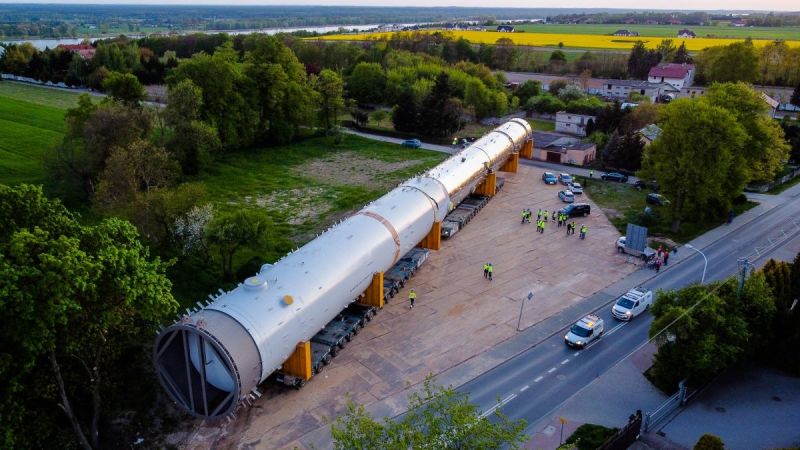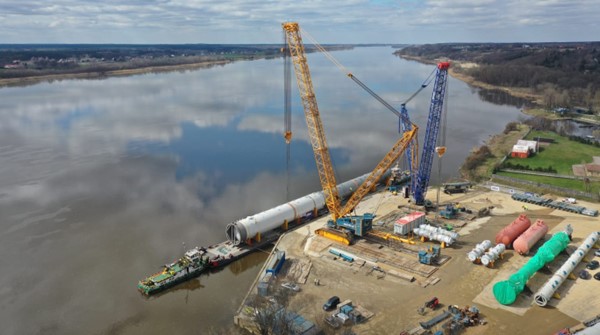

What do you do when you have to transport over 100 pieces of equipment 330 kilometres down one of Europe’s last wild rivers?
Poland’s longest river, the Vistula, is considered “wild” because for at least some portions of its course, no classification can be granted: that is, there is no guarantee of a minimum draft for sailing. This can be a problem when you must load a barge with critical, 1.000-tonne project components and sail it from Gdansk to Plock, 330 kilometres away.
It can be close to impossible to guarantee safe passage, let alone price out such an operation: there are too many unknowns. Without excellent knowledge of the river itself, a barge and its cargo might easily run aground or become stranded on a sandbank.
A challenge is set
In December 2020, two of Sarens’ clients, Hyundai and Tecnicas Reunidas, formed a joint venture and contacted Sarens to perform logistics activities for the Olefins petrochemical expansion project on behalf of end client Orlen.
But logistics were destined to be a challenge from the beginning: the project would involve transporting over 100 pieces of equipment, some weighing up to 1.000 tonnes and measuring up to 110 metres long, from Gdansk to Plock, Poland.
There would be only one way to do it, and that would mean sailing down one of Europe’s last wild rivers, the Vistula. The 330-kilometre course would be a daunting challenge that presented countless unknowns. Any mistakes or miscalculations, and all would be lost.
A team is assembled
Sarens knew that competitors had already performed preliminary surveys for the project and were in a better position at the beginning of the tendering stage. Nevertheless, no worries: nothing would prove too heavy, too high, or too challenging for a determined and talented team.
To find solutions and price out the project, the Sarens sales team brought in manager of maritime operations, Jan Willems, as well as engineering manager Peter Huygebaert. Together, they started working on the best technical solution for transporting the heaviest equipment at the lowest possible draft, accounting for the numerous bridges that a barge would have to pass along the way.
The team quickly found solutions, but they were difficult to reconcile with publicly-available information about the Vistula River: it would not be enough to assure the client that the operation could be done safely, on time, and on budget.
A river is traversed
Because the river is iced in winter and out of water in summer, the only possible sailing windows would be spring and autumn. But the team needed assurance that transport along the river during those times would be safe.
There would be nothing else to do but to sail it ourselves.
In late October of 2021, Sarens set off on a river survey that would help the team understand, with their own eyes, what was possible for the client’s project. Only by exploring the river could the team confirm their proposed technical approach.
Sarens rented a small boat equipped with the necessary measuring tools and put together a sailing team that included Arkadiusz Brejt, Poland-based SP site supervisor; Andrzej Orent, the Polish captain responsible for marking the navigation channel from Wloclawek to Torun; Jan Willems, manager of maritime activities at Sarens; and Dimitri Laurent, project sales manager.
Over the course of four long days, sailing from sunrise to sunset and sometimes much later, the team began to understand why this river was still considered “wild.” It proved to be an extremely challenging and complex aquatic environment: the boat touched the riverbed several times along the journey, crossed a local barge stuck on a sand bank, and faced strong winds along its course.
But with the journey finally completed, Sarens could issue a complete and well-documented technical report to the client, along with their final offer.
New challenges are conquered
Navigating the river would be the team’s first–but not final–challenge. When the barges finally arrived at the jetty in Plock, they would have to be offloaded, with a further eight kilometres to go to reach the urban job site. The route to the job site would note be easy: there was a bridge to pass, a slope to overcome, roundabouts to be modified, light poles to be removed, high voltage lines and gas pipelines to be avoided, and trees that had to be cut. The USSR-era jetty would also be an issue, as technical information about it was scant.
Fortunately, Sarens project engineer Adam Malik was based near the job site and travelled to it multiple times to take necessary measurements and confirm engineering drawings with site surveys.
To successfully fulfil the client’s requested scope, Sarens joined forces with a top-class logistics company, DSV. Sarens proposed a solution in which DSV would be responsible for port operations in Gdansk, road transport from Gdansk to Plock, conventional barging from Gdansk to Plock, and last-mile transport of general cargo from the Plock quay to the job site.
Sarens would provide special barges for critical items sailing from Gdansk to Plock, barge offloading at the quay in Plock, and last-mile transport from the quay to the job site for critical items. Sarens and DSV would both also handle quay arrangement, road clearance, and permitting from the quay to the site.
A project is won
Thanks to our extensive river survey, Sarens’ talented and committed team, and our key partnership with DSV–and after ten revisions to the official offer–Sarens received the Letter of Award in May 2022. This was close to 18 months after receiving the initial request for a quote, and the first technical investigations.
Operations are finalised
Once won, the project was transferred from Sales to Operations, under the leadership of project manager Claude Jacobs. One of his team’s priorities was performing an analysis of the quay in Plock to determine maximum allowable ground-bearing pressures that would guarantee safe unloading operations, as the quay had never before been used to unload such large loads.
The team performed studies in the autumn of 2022, ultimately finding that the quay would not be optimal for placing cranes loaded with 900 tonnes of equipment. The two available solutions would be to either reinforce the quay through costly civil works, or to optimise lift engineering. This would involve using a higher-capacity crane, increasing its radius to land on stronger points along the quay, and completely matting the site to ensure adequate ground distribution.
Opting for the second solution, the team opted to mobilise a 1.250T Demag CC6800 crawler crane and a 650T crawler crane instead of the originally-planned pair of 650T crawler cranes. This would ensure safe unloading operations.
The operation succeeds
As part of this complex operation, Sarens transported several critical loads for our clients. Last-mile transport to the site was performed at night via Kamag K24 SPMTs.
The most critical operation involved transporting the wash tower, a massive component weighing 900 tonnes and measuring nearly 100 metres long. As Sares project sales manager, Dimitri Laurent, puts it:
“Transport of a 900T cargo is not easy. Transport of a 900T cargo in an urban environment is not easy at all. Transport of a 900T cargo in an urban environment, with a length of over 90 metres and an eight metre diameter…this is a real challenge. Together with our partner DSV, we overcame the challenge and transported the wash tower over six kilometres for our client. Congratulations to all the team involved.”
Sarens would like to thank everyone involved in making the complex, multi-faceted project possible, from the sales to the operations stage. We are especially proud of the engineering, operations, and management teams–as well as everyone at Sarens Poland–for coming together to make it happen!